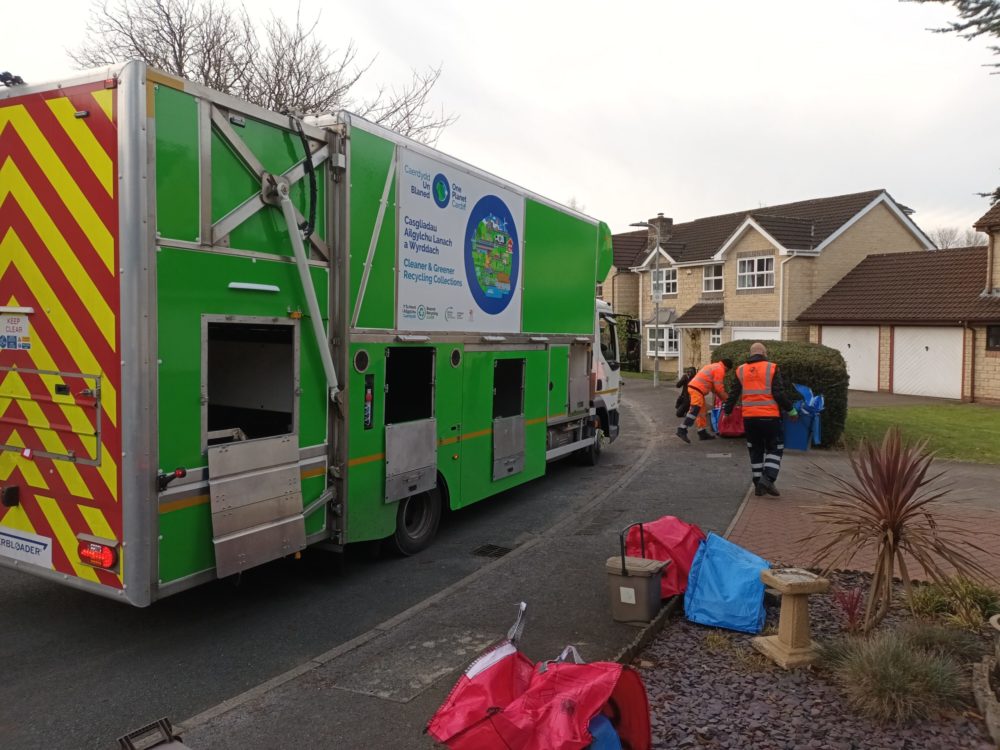Rollout of Cardiff recycling scheme to be completed this month

The roll out of a new method of recycling in Cardiff will be completed later this month.
Cardiff Council started introducing the ‘sack-sort’ separated recycling method, which involves residents separating their waste into different sacks and boxes at home before collection, in 2022 as part of a trial.
The final phase of the rollout for houses will begin on Monday, January 20, extending the scheme to 36,400 homes in Butetown, Canton, Creigiau, Cyncoed, Fairwater, Llanishen, Llanrumney, Old St Mellons and Riverside.
From January 20, residents in these areas who do not live in purpose-built flats will start receiving their new recycling containers, with the first collections scheduled to start on Tuesday, March 4.
Bespoke scheme
A new bespoke scheme for purpose-built flats will follow, but further information won’t be provided until later in the year.
The separated recycling scheme has proved unpopular with some people, with residents complaining about a lack of space to store containers and the potential for recycling sacks to blow away when left out on the street.
However, the council argues the scheme reduces the contamination of recyclable materials with non-recyclable waste.
The local authority said 96% of the products presented to it for recycling under the new scheme can be recycled, compared to 70% under the previous co-mingled scheme.
Combat climate change
Cardiff Council’s cabinet member for waste, street scene and environmental services, Cllr Norma Mackie said: “The rollout of the new recycling scheme is designed to help residents, and the council recycle as much household waste as possible.
“It gives everyone an opportunity to do their bit to help combat climate change.
“The remarkable improvement in recycling which we have seen in the parts of the city where the scheme is already up and running is good news, and we want to take this opportunity to thank residents for getting on board with the scheme and adapting to it so quickly.”
One issue the council said it faced with the co-mingled scheme was food being thrown out with recyclable waste in the same bags, causing birds and other animals to tear them open.
It said under the new scheme, the contamination rate has dropped from 30% to 4%.
Cllr Mackie added: “In many instances, those bags would contain food waste or dirty nappies, among other things, causing a nuisance to staff who had to sort the waste at our depot. This unrecyclable waste then had to go for incineration leading to higher costs.
“The non-recyclable waste incorrectly placed in green plastic bags, especially food, also creates issues with animals and birds breaking open bags on the street, scattering litter across our roads.”
The containers for the separated recycling scheme include:
A blue caddy for glass bottles and jars
A red sack for metals, tins, aerosols, foil, plastic bottles, pots, tubs and Tetra Paks
A blue sack for paper and cardboard
Along with the new containers, residents moving onto the separated scheme will also receive a cover letter, a detailed booklet, and a quick guide information sheet.
Residents can request extra sacks to recycle their waste and there is no restriction on how much recycling people can present.
Extra weight
Cardiff Council said extra weight has been added to recycling sacks to reduce the risk of them being blown away and replacement sacks can be ordered via the council app or collected at some hubs.
A number of residents raised concerns last year after pictures emerged showing the council mixing separated recycling into the same single-compartment bin lorry.
One councillor at the time called it “demoralising” and “frustrating” for residents.
Cardiff Council said issues with some of its new recycling lorries meant there were times when it had to use general waste vehicles to collect separated recycling.
The local authority insisted the use of single-compartment bin lorries “does not have a material impact on the recycling collected”.
It said this is because residents have already ensured the recyclables being collected are of high quality and the material collected in sacks/bottle bins is not being mixed with green bag recyclables.
On top of this, the council argued recyclables are being brought back to the council’s materials recycling facility at Lamby Way, which separates the material by size and weight.
To collect the separated recyclables, waste vehicles with two separate chambers at the back of the vehicle are used.
The recycling from the blue sack goes into one side of the vehicle and the recycling from the red sack goes into the other.
A separate vehicle is being used to collect the glass jars and bottles.
Support our Nation today
For the price of a cup of coffee a month you can help us create an independent, not-for-profit, national news service for the people of Wales, by the people of Wales.





All studies show that there is a consistent 10% increase in recycling volume in comingled recycling compared to kerb separated recycling. However there is increased cost involved in processing, mechanical or manual. Whilst Wales has achieved the second highest recycling rates in the world using mainly comingled streams it is likely this rate will decrease by introducing kerbside separation. This is because it depends on pubic compliance. Many households which currently recycle will revert to just black bag it. Kerbside separation also means streets become cluttered and litter prone.